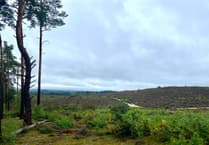TOWN residents have expressed concerns about the loss of trees along the Petersfield Road (A325) in Whitehill.
Described as the southern “gateway” into the town, the prominent work has left some Whitehill and Bordon residents wondering why the trees are being felled and just how many might face the axe.
This week the Forestry Commission, which grants permission for such activity, explained that the work was being carried out by the Amphibian and Reptile Conservation Trust.
Forestry Commission spokesman Andy Glover said the land will be “replanted with species more suitable to the area”.
The scheme aims to connect two important pieces of land for the rare natterjack toad, which lives locally and requires open space to thrive. As a protected species, it needs all the help it can get.
Whitehill and Bordon county, district and town councillor Adam Carew said he had “received a large number of complaints about the amount of trees being felled along the west of the A325 (Blackmoor side) as you approach Whitehill”.
Among the concerns are circulating rumours that the land is being prepared for a caravan park. But Mr Carew added, as the land is both situated in the South Downs National Park and is a Special Protection Area, the idea of it hosting caravans would be “sheer lunacy”. The boggy Woolmer Forest landscape also makes that concern unlikely.
“Although the felling is on private land and being done at the right time of year, the sudden removal of these trees without any communication to local residents has come without warning and clearly taken residents by surprise,” Mr Carew said.
“Most of what is being removed is for ecological reasons to return it (the land) to heathland which, on a global scale, is rarer than rainforest.”
While most people would not be too worried about the loss of plantation pine, he said, it was “essential” that the felling “retains a green shelter belt of oaks along the A325 as the Ministry of Defence has done on the ranges opposite (east side)”.
Mr Carew said these iconic trees, which he estimates to be between 100-200 years old, form “our historic and well-loved green corridor as you enter the town”.
“They are part of our sense of place in Whitehill and Bordon,” he added.
“Considerable efforts are being made to ensure we join up this green gateway with native trees along the relief road and along the A325 to protect our much-loved countryside feel.
“I fought hard to ensure we were included in the National Park and it would be an appalling shame if we were then to lose these oaks as you enter our green town from the Whitehill end. The thinner the shelter belt, the more prone the trees will be to wind blow across the road which, due to the thickness of the trees, has never been an issue.
“The thinning of loss of tree screen will also result in more air, noise and light pollution which will not be good for the heathland soils, its rare species or our residents who may suddenly notice more traffic noise as a result.
“It is worth noting that in creating the Shipwrights Way (on the opposite, east side of the A325), Hampshire County Council and the Ministry of Defence navigated this carefully through the shelter belt without removing too many trees, so it is still well screened from the A325. If they can do that on one side, I am sure these contractors can save a few metres of oak trees on the other.
“In heathland management everything is a balance. It is a man-made habitat and the removal of trees is essential to prevent natural succession and loss of rare heathland to secondary woodland but I do hope that there is sufficient sensitivity to retain our shelter belts on both sides of the A325 to protect our town’s countryside image now and for future generations.”
Angie Julian, from the Amphibian and Reptile Conservation Trust, said a sub contractor had been hired to carry out the work and the trees were being felled to create habitat linkages between two important sites for the European-protected natterjack toad.





Comments
This article has no comments yet. Be the first to leave a comment.